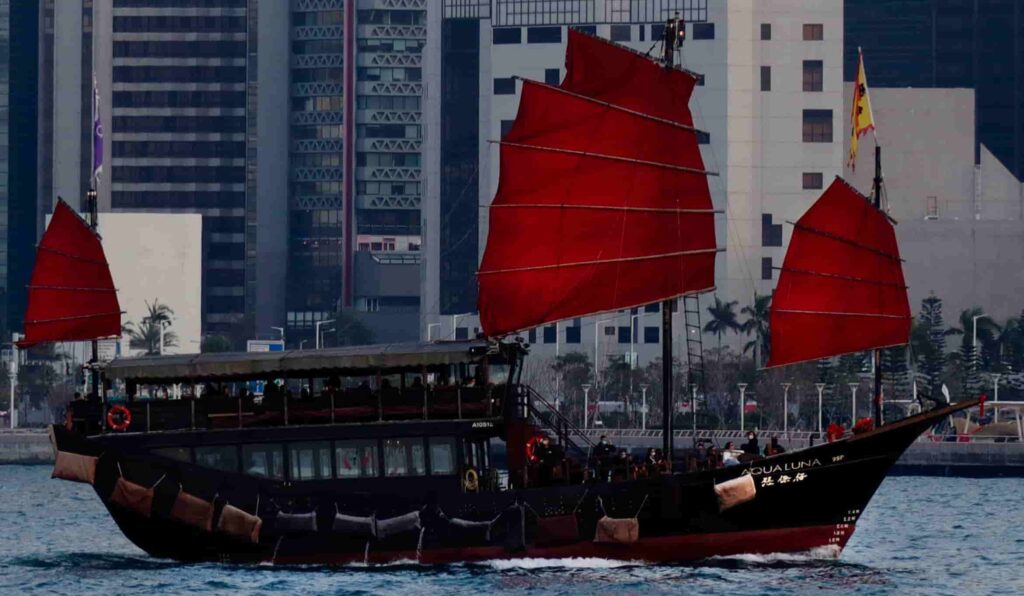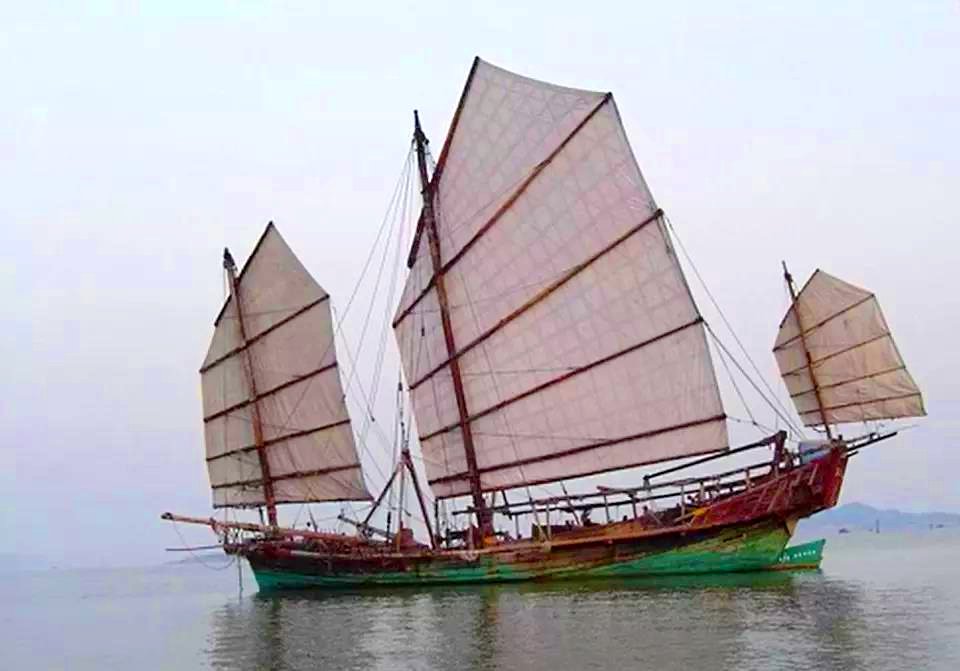
During my travels in Southeast Asia, I learned how Chinese jinxes revolutionized sea travel. A local guide explains how these remarkable ships with their modern rudders and efficient sails made long-distance travel safer and faster. Hearing about their role in global trade and exploration really highlighted the innovation behind these ancient ships.
Chinese junks revolutionized seafaring with their innovative designs, which included watertight compartments, efficient sails, and modern rudders. These ships made long journeys safer, faster, and more reliable, transforming global trade and exploration.
What Was a Chinese Junk?
A Chinese junk was a traditional Chinese sailing vessel used for a variety of purposes over many centuries, including maritime trade, fishing, transportation, and warfare.
1. Design:
Jinks feature a flat-bottomed hull, a central rudder, watertight bulkheads, and high stiffness with a projecting bow. They were constructed using iron nails and clamps, and could feature up to five masts with square sails. The sails, made of linen or mat with bamboo strips, were designed to be adjusted, opened and closed like Venetian blinds for greater control over the wind.
2. Construction:
These ships were designed to withstand rough seas while being easy to maneuver. The hull was divided into watertight compartments, or bulkheads, making the hull exceptionally strong and seaworthy, able to withstand damage and stay afloat.
3. Uses:
Jinks served a variety of purposes, including fishing, transportation, trade, warfare, and exploration. They were crucial to maritime trade routes in East Asia, Southeast Asia, and the Indian Ocean, facilitating long-distance cultural and economic exchange.
4. History:
The earliest reference to junk dates back to around 2800 BC, and they were integral to ancient Chinese culture for thousands of years. Jinks were influenced by Austronesian and Southeast Asian ship designs and incorporated ocean-going technologies from Southeast Asian k’un-lun po trading ships.
5. Regional Variations:
The design and construction of junks varies in different regions, periods and purposes, influenced by available materials and external cultures. Each coastal region of China has developed its own methods of making these ships.
6. Influence on Western Shipbuilding:
Jinks incorporated several technological advances in sail and hull design, many of which were later adopted by Western shipbuilders, influencing global maritime engineering techniques.
How Big Was A Chinese Junk?
The size of Chinese junk varies based on its purpose, region and era. Smaller boats, usually 20 to 30 feet long, were used for fishing, transportation, and regional trade. Large junks, such as those during the Ming Dynasty, could be over 300 feet in length and were used for long-distance travel and military expeditions.

These “treasure ships”, such as those commanded by Admiral Zheng He, could carry hundreds of crew, soldiers and supplies. The size and design of the bins reflected their intended function, the materials available and the technological advancements of their time.
How Junks Changed Ocean Travel
Jinks, traditional Chinese ships, were instrumental in revolutionizing seafaring by introducing important design innovations such as watertight compartments, large rudders, and efficient sail systems. These features not only increased the safety and maneuverability of ships, but also facilitated long-distance voyages across vast and often unpredictable waters, transforming maritime trade and exploration, particularly in East and Southeast Asia.
1. Key points about how junks impacted ocean travel:
- Watertight compartments: A key innovation was the addition of watertight bulkheads within the hull, ensuring that the junk would remain afloat even if part of the ship was damaged, thus improving safety on long sea voyages.
- Large rudder design: Junks were equipped with a large, centrally mounted rudder on the stern, providing superior control and maneuverability, especially in tight or crowded harbors, and ensuring greater stability in rough seas.
- Adaptable sail system: The unique “junk rig” sail system, consisting of multiple panels, allows easy adjustments to catch wind from different directions, improving sailing efficiency and enabling efficient navigation in varying wind conditions. .
- Lightweight construction: Built of lighter materials, junks were easier to handle and maneuver than many other ships of the time, increasing their versatility on both short and long voyages.
- Impact on trade and exploration: These design advances enabled the development of extensive maritime trade routes, particularly along the Maritime Silk Road, promoted cultural exchange and exploration, and helped establish China as a dominant maritime power.
What Were Junks Used For?
Junks were versatile ships used for a wide range of purposes in China throughout various historical periods. Primarily, they were used for maritime trade, fishing, transportation, and military activities, playing a significant role in shaping the dynamics of regional and international exchange.
1. Maritime Trade:
Junks were integral to the expansion of maritime trade networks, especially during the Tang, Song, and Ming dynasties. They facilitated the movement of goods such as silk, tea, porcelain, and spices, connecting China with Southeast Asia, India, the Arabian Peninsula, and beyond. Their large cargo holds and ability to navigate both coastal and open sea routes made them ideal for transporting valuable goods over long distances.
2. Fishing:
The design of the jinks made them well-suited for fishing activities, especially in coastal waters. Small junks were commonly used by fishermen to harvest seafood, providing a reliable source of livelihood in port cities and coastal areas and supporting the local economy.
3. Transportation:
Junks served as essential transport vessels for passengers and goods within China and to neighboring regions. They were crucial for moving people, materials, and military personnel, especially on the vast network of rivers, lakes, and coastal waters that characterized China’s geographical landscape.
4. Military Use:
Warships played a vital role in naval warfare. Their sturdy construction, large size, and advanced maneuverability allowed them to serve as warships in naval wars, especially during the Song and Ming dynasties. They were used to transport troops, engage in naval defense, and protect trade routes from piracy and external threats.
5. Exploration:
Junks were also used in exploration, such as the remarkable voyages led by Admiral Zheng He during the Ming Dynasty. These expeditions, which reached as far as East Africa and the Arabian Peninsula, exemplified the potential of junk for long-distance travel and its importance in promoting cultural exchange between China and other civilizations.
What Was The Biggest Junk Ship Ever?
The largest junk ship ever built was Admiral Zheng He’s “Treasure Ship,” which played a central role in his seven voyages during the Ming Dynasty. These massive ships, up to 400 feet long, were much larger than any other ship of the time. They could carry hundreds of crew members, military personnel, and considerable cargo.

The ships were equipped with advanced navigation tools and were designed for long-distance sea voyages. Treasure ships were a symbol of the rise of maritime engineering during the Ming Dynasty and were key to Zheng He’s diplomatic and trading missions to the Indian Ocean and beyond.
FAQ’s
Why Is A Chinese Ship Called A Junk?
The term “junk” is believed to be derived from the Malay word “djong”, which refers to a type of traditional seagoing vessel. Over time, the term became associated with Chinese ships, which were known for their distinctive design and were widely used in maritime trade and exploration.
Are Chinese Junks Still Used?
Although Chinese junks are no longer widely used for commercial or military purposes, they remain prominent in cultural heritage and are occasionally used for tourism, traditional fishing, and ceremonial purposes in coastal areas of Southeast Asia and China.
What Was The Impact Of The Junk Ship?
The junk ship revolutionized maritime trade and exploration by introducing modern navigational and construction techniques, enabling safe, long-distance voyages, and fostering extensive cultural and commercial exchange across Asia, the Middle East, and beyond.
Were Junks Used In The Indian Ocean Trade?
Yes, junks were integral to the Indian Ocean trade, facilitating the exchange of goods such as silk, tea, and porcelain between China, Southeast Asia, the Arabian Peninsula, and East Africa, contributing significantly to the region’s maritime economy.
How Did Junk Ships Increase Trade?
Junk ships expanded trade by offering larger cargo capacities, advanced navigational capabilities, and greater stability, which allowed for more efficient long-distance travel and the expansion of trade routes to Asia, the Indian Ocean, and beyond.
Conclusion:
Finally, Chinese junks played a significant role in revolutionizing seafaring, trade, and exploration, with their innovative design features, such as watertight compartments and efficient sail systems. These innovations not only increased the safety and maneuverability of long-distance travel, but also facilitated the development of global trade networks, fostered cultural exchange, and established China as a maritime power.






























